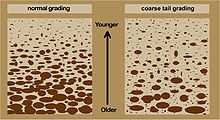Graded bedding


In geology, a graded bed is one characterized by a systematic change in grain or clast size from the base of the bed to the top. Most commonly this takes the form of normal grading, with coarser sediments at the base, which grade upward into progressively finer ones. Normally graded beds generally represent depositional environments which decrease in transport energy as time passes, but also form during rapid depositional events. They are perhaps best represented in turbidite strata, where they indicate a sudden strong current that deposits heavy, coarse sediments first, with finer ones following as the current weakens. They can also form in terrestrial stream deposits.
In reverse or inverse grading the bed coarsens upwards. This type of grading is relatively uncommon but is characteristic of sediments deposited by grain flow and debris flow.[1] It is also observed in eolian ripples. These deposition processes are examples of granular convection.
A favored explanation is kinetic sieving.[2]
See also
References
- ↑ Tucker, M. 2003. Sedimentary Rocks in the Field. Wiley, 244pp ISBN 978-0-470-85123-4
- ↑ http://rspa.royalsocietypublishing.org/content/462/2067/947.full Time-dependent solutions for particle-size segregation in shallow granular avalanches, (2005)J.M.N.T Gray1*, M Shearer2 and A.R Thornton1
- Monroe, James S., and Reed Wicander. The Changing Earth: Exploring Geology and Evolution, 2nd ed. Belmont: West Publishing Company, 1997. ISBN 0-314-09577-2 pp. 114.